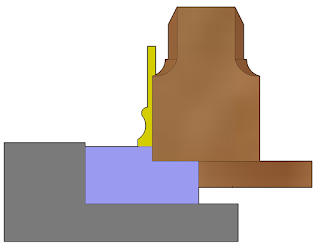Note 1: This article will be a further addition to my increasing FAQ page. Check it out.
Note 2: My wife, friends and
editors always tell me that all of my introductions are too long. Deal with
them or delete them. I consider them desirable.
Please consider these
paragraphs an introduction to reasons these tools--hand tools--may find
relevance in your shop.
(This picture only serves as click bait.)
The first financial commitment of my path into woodworking
was the purchase of a table saw. With slightly more woodworking experience, I
quickly acquired a 6” jointer and less expensive 12” lunchbox planer. With more
practice and increasingly wild dreams I accepted that the combination of my
jointer and planer was not able to prepare the desired dimensioned wood of my
future.
I priced the various options for jointers and planers. I
could purchase a 12” jointer for $2,000 or more (up from only several hundred,) but then I’d have +5x the price invested
into my jointer over my planer. At that point, I might as well put another
$1,500-$2,000 into a 16” planer. This inevitability, of course, would only
leave me wanting a wider jointer, then wider planer, and then jointer, and so
on. I was left going through the back and forth, chasing the “Jointer High.”
Do you recognize this?
The “Jointer High,” as I’ve termed the above, is the idea
that if you buy the largest sized jointer you choose to afford then you feel
that you owe yourself a similarly expensive planer, which will be much wider. Then
you consider spending more on a jointer and more on a planer and the circle
continues. Buy the widest of both of these and you still won’t have the ability
to flatten the top of a 34” wide piece for a single board, pie-crust table.
At this point you do more research and you think that you
will just build a router jig for that pie-crust table you’re considering only
to recognize that you will not be able to flatten the bench top you intend to
build with the jig you propose to construct. You then consider buying a wide
belt sander or CNC machine because you’ll have to store the longer/wider router
jig and you…
Stop. You’re
frustrated…
There are two groups of
woodworkers that I tend to disappoint. One of them is the hand tool-only crowd.
These quickly disheartened craftsmen assume that I only use hand tools because
I spend all day making them. I, however, am a hybrid woodworker. I use hand
tools when I am able to accomplish my goal more completely, or more quickly, or
without the inherent limitations, which there always are with machines.
These previous pitfalls may be
avoided. Introduce a functioning fore plane and try plane into your craft and
you may likely content yourself with that 4” Rockwell jointer you’ve seen on craigslist
versus the 12” model you’ve considered coupled with your dreamed 24” planer.
You need not ever be limited by your tooling if you’ve chosen the correct
supplemental tools to your chosen machinery. Hand tools often provide the idea
of infinity that all machinery cannot.
Your ability to use hollows and
rounds in your work will introduce the same idea of creativity that using a
fore or try plane did: exactly create what you want by crafting. Learn to use
these bench planes to supplement your machinery then you won’t let your current
mechanical tooling affect your actual choices.
Hollows and rounds offer the
same idea and pursuit to all: infinite options. Know that committing to hollows
and rounds does not commit you to making hundreds of feet of a profile for new
crown moulding in your living room and garage. Hollows and rounds offer you the
ability to create your thoughts or reproduce a previous maker’s conclusion, not
some manufacturer’s interpretations of either.
The ability to create flat
surfaces with hand tools offers you the ability to make any surface flat in the
same way that a hand saw allows you to make dovetails of any depth, width, angle
or spacing. Hollows and rounds similarly offer you infinite edges and moulded
decoration.
The choices that hand tools
offer may seemingly be neither apparent, necessary nor desirable in every shop.
A varying degree of hand tools have their place, however, in every shop. Consider
the options.
How do hand tools fit into your
shop?
Do you like this presented idea
of ‘infinity’. Of course, maybe you just like listening to baseball or music
more than the screeching whine of a router along with your dust collector which
does not collect all of the dust. Or maybe you like not having the physical
threat that your machines create while spinning at 15,000 rpm. Heck, maybe you
just want moulded surfaces that remain clean and sharp because they do not need
to be sanded with 3 different grits of sandpaper.
(Dedicated plane for a harpsichord's bridge. The routed profile above will not be the same after machine marks are removed.)









































